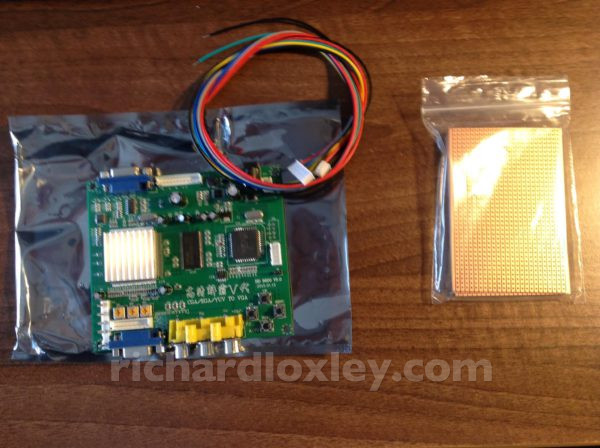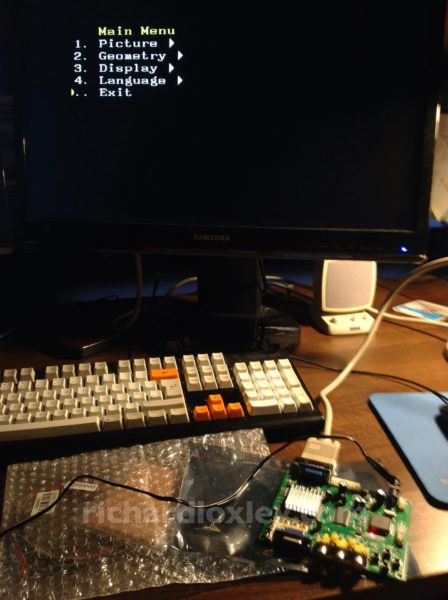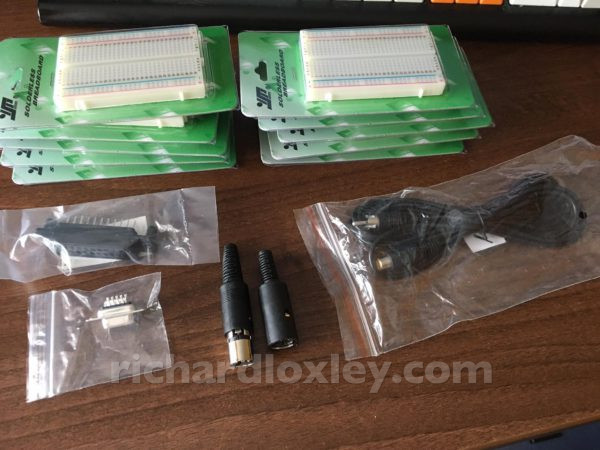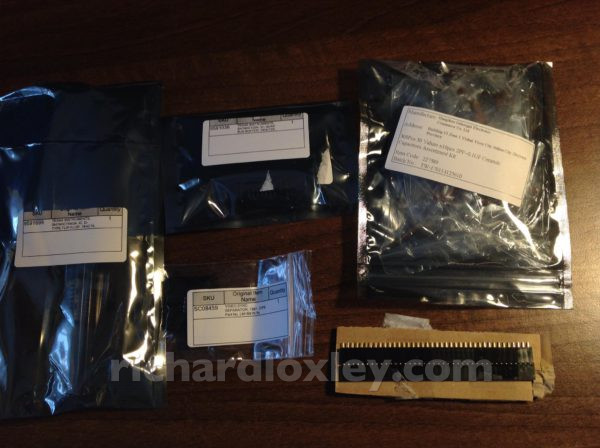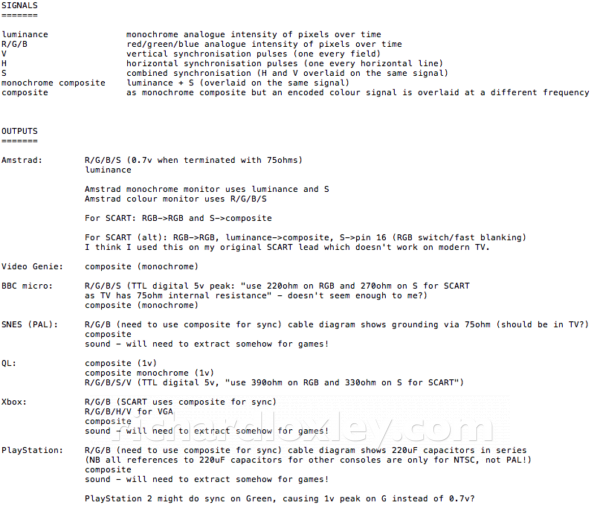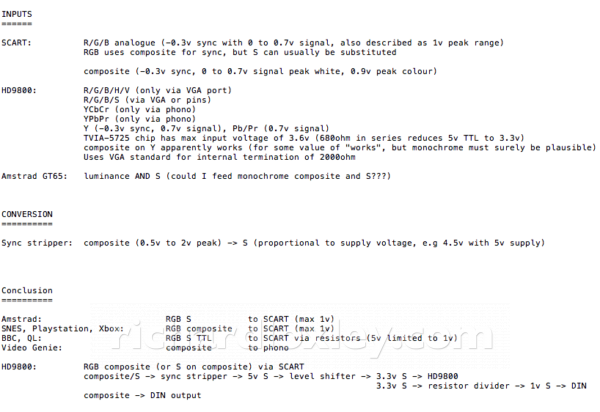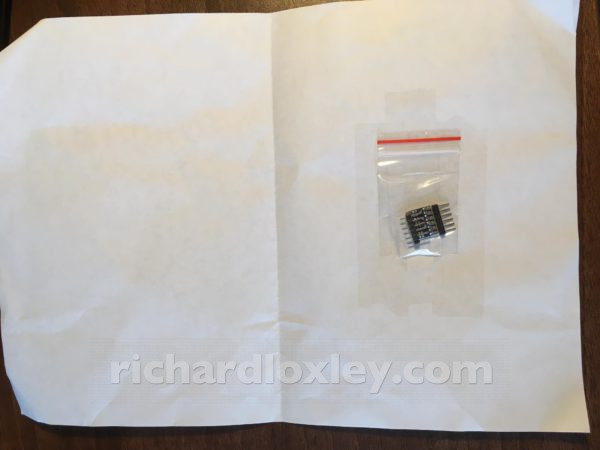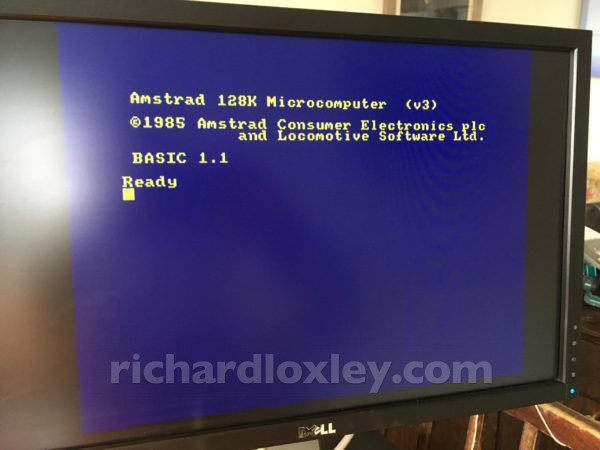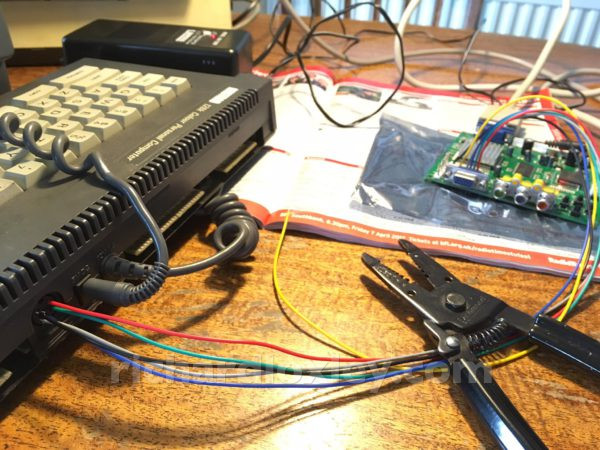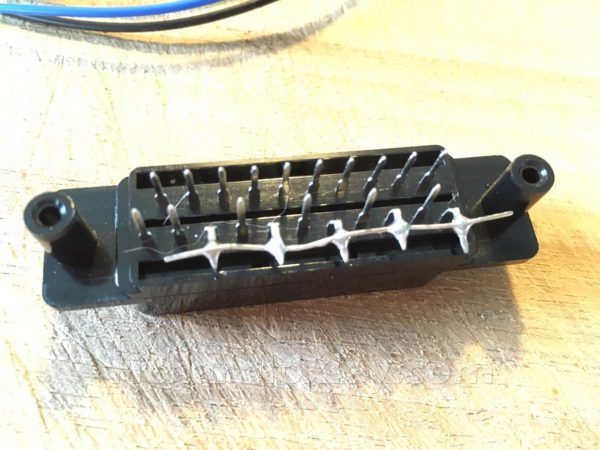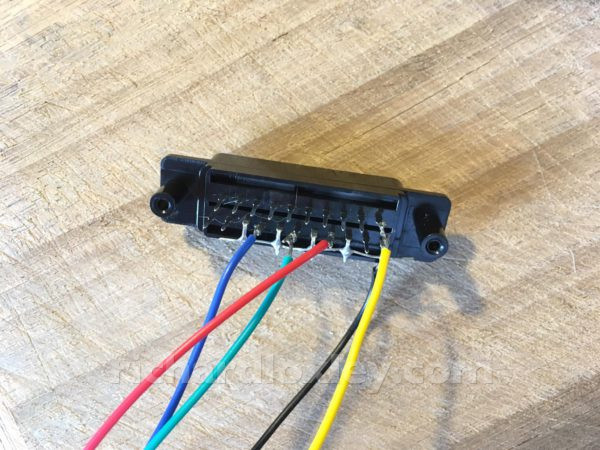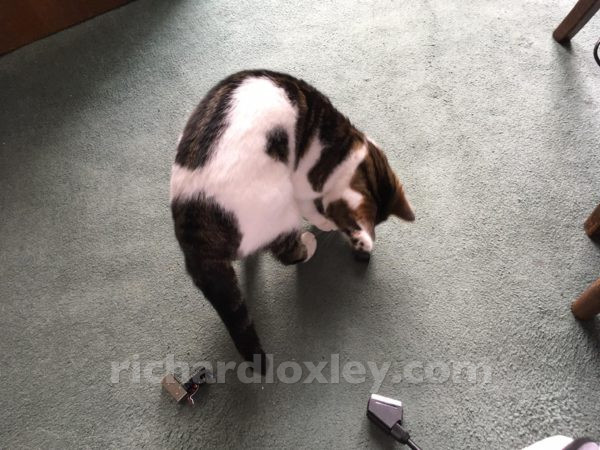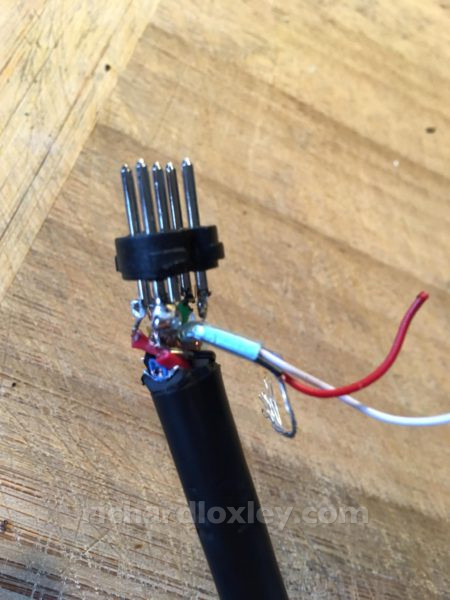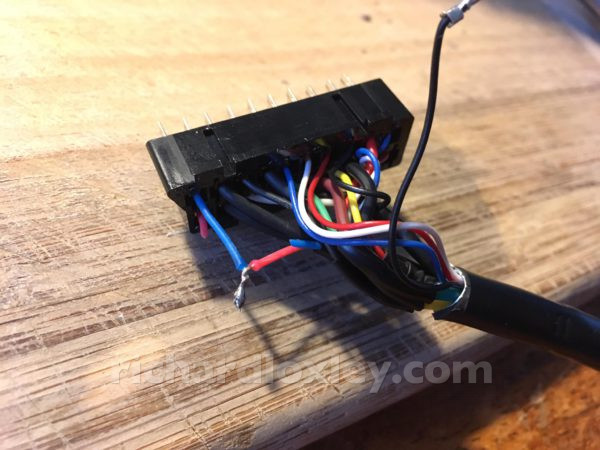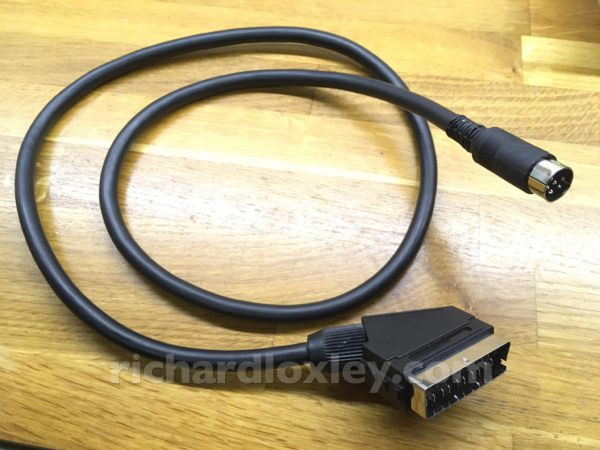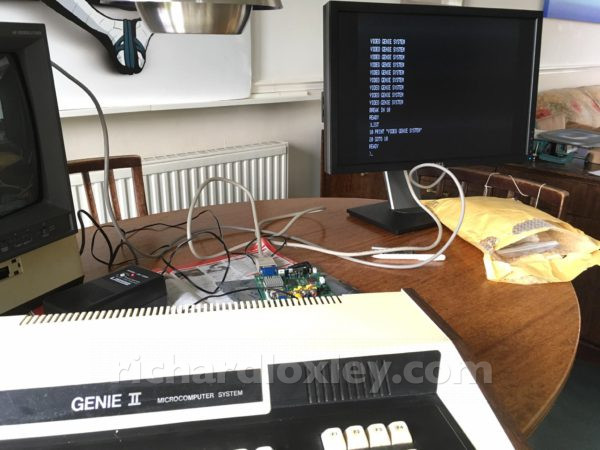After my initial research and designs, I started ordering components for the video converter part of my RetroMatic 2000.
It’s based around a GBS8200 board (or the HD9800 clone version), with extra circuits to modify the input (clean up the sync signal) and output (generate scanlines).
Here’s a scrapbook from my prototyping phase…
First component deliveries: the HD9800 frame buffer board (clone of the GBS8200 I’ve written about previously) and some veroboards for soldering up permanent circuits (after I’ve prototyped them on breadboards).
Initial cursory test of the HD9800.
I’m using a universal power adapter for now (I need to rescue an old mobile phone power supply from someone who no longer needs it).
I don’t yet have the connectors/electronics to connect it to an old computer, so just the on-screen display for now. I had to hunt around to change it from Chinese to English. You’d think they’d put the ‘Language’ menu title in both languages, but no!
I will in fact be deactivating the chip that puts up the OSD, and replacing it with an Arduino controlling the frame buffer chip directly.
Still, it was interesting to see the OSD seemed to allow you to change the horizontal and vertical scaling, as well as the output resolution, so I may yet be able to find the right register values to put a 576 line PAL display windowed inside a 800×600 VGA output resolution, without having weird pixel-boundary scaling issues.
Parcels! Today is the midpoint of the estimated delivery time for all my components. Let’s see what’s in them!
- 10 bread boards for prototyping
- SCART socket and 6-pin DIN plug for connecting Amstrad computer to HD9800 (via an old cannibalised SCART lead)
- 6-pin DIN socket and phono extension lead to connect Video Genie composite video output to Amstrad monitor
- VGA 15-pin DSUB socket to allow VGA output of HD9800 to be diverted via a homemade scan line generator
I still don’t have any of the electronics to make the scan line generator, or the sync stripper, or the Arduino to HD9800 interface, so I can’t build anything substantial yet. But I can solder up and test the Video Genie video lead. And I can solder up the Amstrad to SCART to HD9800 as long as I don’t test it till I’ve built the sync stripper!
Today’s delivery:
- sync separator chip (extracts a pure sync signal from a composite video signal)
- 300 assorted capacitors (I only need 2 of them to make the sync separator chip work, but thought I might as well have a selection for future projects!)
- header pins/sockets so I can install an Arduino in a permanent circuit without having to solder it into place
- two ICs (flip flop and a buffer) which can make a scanline generator circuit to hide alternate video scan lines on the VGA output to simulate the half-resolution 8-bit computer display
Annoyingly there is still one component that hasn’t arrived: a 3.3v-5v level converter board. I need it to get sync voltages right, and to get the Arduino serial link (5v) to talk to the frame buffer board serial link (3.3v). The claimed delivery time was Thursday. Friday’s post has been and gone, and still no sign of it ![]()
Today’s job is to redesign my circuits. Yesterday I realised that the Amstrad puts out a different video signal than I’d thought, meaning that I don’t need the sync separator for that signal. But most SCART based video does need it. So do I still put a SCART input on my video converter using the sync separator? And if so, how do I feed my Amstrad video into the converter if not via the SCART socket? Hmm.
I’ve started cataloguing what type of video signals are output by all the old 8-bit devices I want to use, and what video signals are accepted as inputs by the various displays I want to use.
Then I can design the converter box to do all the conversions I need!
Today’s delivery: the final parcel, a 5v-3.3v level converter. Only 2 days late!
It was so small I initially thought they’d sent me the wrong component. I was expecting something 5-10 times bigger!
Now I have everything I need to start building a prototype 8-bit-computer video converter.
And a successful first test feeding the Amstrad RGBS signal through the HD9800 converting to VGA for the flat panel:
The picture isn’t perfect, and it’s trying to deinterlace a progressive signal, but my future modifications should hopefully fix that.
This is going to work I think ![]()
This is the level of my prototyping: bare wires loosely shoved into a DIN socket.
I guess I should solder up some proper cables next!
I used a nice hack I saw online for soldering all the ground pins on the SCART socket together in one go ![]()
SCART socket soldered up: red, green, blue, multiple grounds, and yellow (composite video but can also accept pure sync).
Next up: an Amstrad 6-pin DIN to SCART lead.
Jess is enjoying playing with the spare bits from the SCART cable I’m cannibalising ![]()
I absolutely hate soldering cables!
I *think* this is done: R,G,B,sync, and *5* grounds (one per signal, plus a shield) soldered into 5 pins of a 6 pin DIN. So 5 ground wires on to one pin! Nightmare.
I’ve also left the 3 audio wires intact in case I want to feed the Amstrad audio into it in the future.
Hope it works. Don’t want to have to redo it ![]()
Dammit. I tested the ‘finished’ cable, and the sync signal wasn’t connected ![]() (The sync is being sent on the composite video pin.)
(The sync is being sent on the composite video pin.)
Checking it carefully I find I’ve wired it to the video out, not the video in. Huh? I double and triple checked the wiring diagrams before soldering.
Duh! Whereas RGB on a SCART is straight through (one path for input or output), composite video on SCART has two paths, one for in, one for out. But because of this, the cables are ‘twisted’, the input of one end connects to the output of the other, and vice versa! So I’d wired up the wrong pin ![]()
I’ve already cut off the excess cable of the correct video wire at the DIN plug end, so my only option was to swap the wires at the other (SCART) end.
I tried to remove the SCART pins, but they have a barb to lock them in place, and 20 odd minutes didn’t budge them.
So I’ve cut the wires going into the SCART plug and resoldered them:
NB if I ever use the audio, I guess I’ve made the same mistake there, and will have to resolder those pins at the SCART end.
The finished Amstrad to SCART cable:
Bastard to do.
Checked all pins – fine. Assembled it – one pin not connected. Disassembled it – now three pins not connected. Resoldered those three, reassembled – a different pin not connected. Disassembled, resoldered all five pins, reassembled – now everything finally connected!
And plugging it into my newly soldered SCART socket on the HD9800 I get the same success as my bare wire test this morning ![]()
My hunch about feeding monochrome composite video into the Y input of YPbPr was correct!
Here’s the HD9800 converting the Video Genie output into VGA for a flat panel ![]()
(Limitations: the picture is as wobbly as on an analogue monitor, it only works on certain resolutions, and the HD9800 is trying to deinterlace a progressive signal. My Arduino mod should fix the last one. Not sure about the others.)
Also, I’m getting random white ‘sparklies’ over the picture. This is a common complaint. One very knowledgeable techie said he got rid of them by underclocking the RAM on the HD9800, something I can try using my Arduino mod.
Next up: try to reprogram the TV5725 chip on the HD9800 board!
